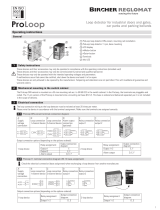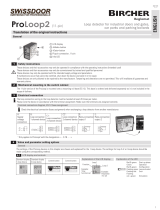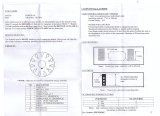Page is loading ...

Safety instructions
1
These devices and their accessories may only be operated in compliance with the operating instructions (intended use)!
These devices and their accessories may only be commissioned by trained and qualified personnel.
These devices may only be operated with the intended operating voltages and parameters.
If malfunctions occur that cannot be rectified, shut down the device and send it in for repair.
These devices are only allowed to be repaired by the manufacturer. Tampering and alterations are not permitted. This will invalidate all guarantee and
warranty claims.
The loop connection wiring to the loop detector must be twisted at least 20 times per meter.
Please wire the device in accordance with the terminal assignment. Make sure the terminals are assigned correctly.
1
L
OOP DETECTOR
Documentazione
Tecnica
T20
r
ev. 3.0
0
1/2010
©
CAME
CANCELLI
AUTOMATICI
119RT20-EN
SMA - SMA 2 - SMA 230
ENGLISH
Operating instructions for Installing and Start-up (Translation)
Mounting and electrical connection
SMA is mounted directly onto a standardized 35-mm mounting rail.
The terminals for all connections are coded pluggable terminals.
2
Supply voltage
Loop connection
1-channel device
Loop connection
2-channel device
Alerting Output 2nd output
+/~
–/~
A1
A2
L3
L4
L3
L4
L5
L6
1
2
31
32
34
common
n
c
n
o
1
4
11
12
c
ommon
nc
no
24
21
2
2
common
nc
no
Relay response to malfunctions (see chapter 6 Troubleshooting):
General
Explanation of the LCD display
Explanation of the LED
Standard display
1-loop device
Standard display
2-loop device
Control button Control button
1
1
2
Mode
Sim1
Data
Sim2
1
2
Loop 2,
output 2
Example:
Parameter «h»
set
Function
Example:
Time
function set
Loop 1, output 1
Info
Red: Start-up phase
Green: Operation
Red & green: Configuration
Flashing green: Loop activated
Flashing red: Error
Flashing red + green: Simulation
The settings of the devices in this chapter are shown and explained for the 1-loop device. The settings for loop 2 of a 2-loop device should be made using
the corresponding method.
1.Door/gate
systems
A malfunction causes
the output relay to be
released. The alarm
relay drops out.
2. Barrier
A malfunction causes
the output relay to pick
up. The alarm relay
drops out.
3. Quiescent
current
A malfunction causes the
output relay to be
released. The alarm relay
drops out.
4. Direction logic
(2-loop device
only)
A malfunction causes
the output relays to be
released. The alarm
relay drops out.
Parameters
1: Door and gate The assigned output relay picks up when the loop is activated and drops out when the loop returns to a non-activated condition.
2: Barrier The assigned output relay picks up when the loop is activated and drops out when the loop returns to a non-activated condition.
3: Quiescent current The assigned output relay drops out when the loop is activated and picks up again when the loop returns to a non-activated condition.
4: Direction logic Output 1 switches if an object moves from loop 1 to 2. Output 2 switches if an object moves from loop 1 to 2. Both loops must be
activated for a short time. The outputs are reset again when loop 2 returns to a non-activated condition. Both loops must have re-
turned to a non-activated condition for another direction detection.
0: Loop 2 Loop 2 / output 2 can be deactivated in a 2-loop device.
3
Value and parameter setting options
LCD display and controls
3.1
Basic functions 0 (see Table 4.1a for settings)
3.2

The relay picks up when the
loop is activated and drops
out when the loop is exited.
Loop
Relay
On delay:
The relay picks up after the
time t when the loop is acti-
vated and drops out when
the loop is exited.
Loop
Relay
tt
Off delay:
The relay picks up when the
loop is activated and drops
out after the time t when the
loop is exited.
Loop
Relay
tt
Activation pulse:
The relay picks up when the
loop is activated and drops
out again after the time t.
Loop
Relay
tt
Impulse by leaving the loop:
By leaving the loop,
the relay picks up after
the time t, relay drops out.
Loop
Relay
tt
T
he sensitivity 5 (=Sensitivity) of the loop detector can be adapted in 9 stages: 51 = Lowest sensitivity, 59 = Highest sensitivity,
56 = Factory setting. The sensitivity setting depends on the frequencies (see chapter 3.6 Frequency).
In a device with 2 outputs, output 2 can be either activated or deactivated. In ProLoop 11, output 2 can also be set as an alarm output.
Four different frequencies F1, F2, F3, F4* can be set in order to avoid interference when using several loop detectors. These settings influence the
sensitivity (the sensitivity can be set in the range 1–7 for frequencies F1 to F3). F2 to F4 can be set for inductance < 150 µH and only F4 can be set for
inductance < 75 µH.
The direction logic function can only be used with a 2-loop device. Direction logic must have been set in the basic function (see chapter 3.2). Detection
can be performed from: ➝ Loop 1 to loop 2 ➝ From loop 2 to loop 1 ➝ from both directions
Display after start-up:
1
Touch the «Mode» button once
to change to configuration
mode
Mode
Sim1
1
Display after start-up:
1
2
Touch the «Mode» button once
to change to configuration
mode
Mode
Sim1
1
Mode
Sim1
2
Loop 2 is
selected
Loop 1 is
selected
ASB (=Automatic Sensitivity Boost). ASB is required in order to be able to recognise trailer drawbars after activation.
Basic function 2 «Barrier systems» or 3 «quiescent current» must be set for this function.
P 1 = Protection against power tailure activated: The sensitivity is restricted to 1–5 and the time function to h.
Time functions 1, time unit 2 and time factor 3 (see Table 4.1a for settings)
3.3
Sensitivity 4 (see Table 4.1a for settings)
3.4
Automatic Sensitivity Boost ASB 5 (see Table 4.1a for settings)
3
.5
Frequency 6 (see Table 4.1a for settings)
3.6
Direction logic7 (see Table 4.1a for settings)
3.7
Output 2 8 (see Table 4.1b for settings)
3.8
Protection against power failure 9 (see Table 4.1a for settings)
3.9
1- loop device
2- loop device
2
Signal characteristics with protection against power failure active (Function 9 = 1)
3.9.1
For Activation (e.g. Barriers)
Basic function 0 = 2 Barrier systems
common
nc
no
common
nc
no
Without power Initialisation Free Occupied Free
For Safeguarding (e.g. Barriers, bollards)
Basic function 0 = 3 Quiescent current
Without power Initialisation Free Occupied Free
common
nc
no
common
nc
no
4
Changeover from operation to configuration mode

Function
LCD
display
Button operation
functions
0
- Bas
ic
function
1
Mode
Sim1
1
- Time
function
1
Mode
Sim1
2
- Time
unit
1
Mode
Sim1
Th
is
di
sp
la
y d
oe
s not
go ou
t in t
i
m
e
f
u
n
c
t
i
o
n t
h (
∞
)
3 - Time
fac
tor
1
Mode
Sim1
Th
is
di
sp
la
y d
oe
s not
go out in ti
me
function th (
∞
)
4
-
Sens
i
ti
v
i
ty
1
M
ode
Si
m
1
5
=
S
e
n
s
itiv
ity
5
-
Au
t
o
m
a
t
ic
S
e
n
sit
ivit
y B
o
o
st
AS
B
1
M
ode
Si
m
1
A
S
B s
ta
n
d
s fo
r
A
u
to
ma
tic S
e
n
s
itiv
ity
B
o
o
s
t
6
-
F
requenc
y
1
M
ode
Si
m
1
7
-
D
i
rec
ti
on l
ogi
c
1
2
M
ode
Si
m
1
Thi
s
di
spl
ay
appear
s
onl
y
w
i
t
h
a
2-
l
oop
devi
ce
8
-
O
utput
2
c
onfi
gurati
on
1
M
ode
Si
m
1
9
-
Protec
ti
on
agai
ns
t
power
fai
l
ure
M
ode
Si
m
1
A
-
O
perati
ng mode
1
3
Data
Sim2
Data
Sim2
Data
Sim2
Data
Sim2
Data
Sim2
Notes
Door/gate
systems*
1
Barrier systems
1
Quiescent current
1
Direction logic
1
2
Only 2-loop device:
Loop
2 +
output 2
Deactivate: «1»
Activate: «0»*
2
∞
*
1
On delay
1
Off delay
1
Activation pulse loop
1
Time function pulse
when loop is exited
1
0.1 second
1
1 second*
1
1 minute
1
1 hour
1
The time unit multiplied by
the time factor gives
the set
time.
1*
1
Set value between 1 and 99 by
touching or holding the «Data»
button
6
*
1
S
e
t v
a
lu
e
b
e
twe
e
n
1
(lo
we
s
t )
a
n
d
9
(h
ig
h
e
s
t s
e
n
s
itiv
ity
)
b
y
to
u
c
h
in
g
o
r h
o
ld
in
g
th
e
«
D
a
ta
»
b
u
tto
n
S
e
ttin
g
re
s
tric
tio
n
s
:
F
re
q
u
e
n
c
y F
1
-F
3
:
V
a
lu
e
1
–
7
P
ro
te
c
tio
n
a
g
a
in
s
t p
o
we
r
fa
ilu
re
(with
P
1
):
V
a
lu
e
1
-5
S
witc
h
e
d
o
ff*
1
S
witc
h
e
d
o
n
1
F
re
q
u
e
n
c
y F
4
*
1
F
re
q
u
e
n
c
y F
1
1
F
re
q
u
e
n
c
y F
2
1
F
re
q
u
e
n
c
y F
3
1
B
o
th
d
ire
c
tio
n
s
1
2
L
o
o
p
2
to
lo
o
p
1
1
2
L
o
o
p
1
to
lo
o
p
2
1
2
T
h
e
d
ire
c
tio
n
lo
g
ic fu
n
c
tio
n
c
a
n
o
n
ly b
e
imp
le
me
n
te
d
with
2
lo
o
p
s a
n
d
a
2
-lo
o
p
d
e
v
ic
e
O
u
tp
u
t 2
is
s
witc
h
e
d
o
ff
2
O
u
tp
u
t 2
is a
c
tiv
a
te
d
2
O
u
tp
u
t 2
is
c
o
n
n
e
c
te
d
a
s a
la
rm
o
u
tp
u
t (o
n
ly p
o
s
s
i
-
b
le
with
P
ro
L
o
o
p
1
1
)
2
L
o
o
p
+
o
u
tp
u
t 2
mu
s
t b
e
s
e
t
to
«
a
c
tiv
e
»
Sw
i
t
ched
of
f
*
Sw
i
t
ched
on
If
par
amet
er
9 =
P
1
par
amet
er
5 mus
t
be s
et
t
o of
f
(
5
=
A0
).
Oper
at
i
ng
m
ode
1
E
rro
r
m
e
m
o
ry
sl
o
t
1
E
rro
r
m
e
m
o
ry
sl
o
t
2
E
rro
r
m
e
m
o
ry
sl
o
t
3
E
rro
r
m
e
m
o
ry
sl
o
t
4
P
o
s
s
ib
le
d
is
p
la
y
s in
c
a
s
e
o
f
e
rro
r:
s
e
e
c
h
a
p
te
r 6
o
f th
e
s
e
o
p
e
ra
tin
g
in
s
tru
c
tio
n
s
Button operation
parameter
4.1
Configuration mode
Table 4.1a Settings
T
abl
e
4.
1b
D
i
f
f
er
ent
pr
oduc
t
v
ar
i
ant
s (
s
et
t
i
ng
opt
i
ons
)
*
F
ac
tory s
etti
ng
Note on 2-loop device: After loop 1 has been set, the parameters for loop 2 are set (make the settings using the same procedure) and the settings are not shown in the table with the exception of the direction logic
S
M
A
,
S
M
A
2
3
0
Lo
o
p 2
O
u
tp
u
t
2
N
o
te
s
1
-l
o
o
p d
e
vi
ce
,
2 re
l
a
ys
–
1
-0
/
1
*
1 =
O
u
tp
u
t
2 o
n
;
0 =
O
u
tp
u
t
2 o
ff
S
M
A
2
Lo
o
p 2
O
u
tp
u
t
2
N
o
te
s
2
-l
o
o
p d
e
vi
ce
,
2 re
l
a
ys
a
cti
ve
–
P
a
ra
m
e
te
r
8 i
s
n
o
t
p
o
ssi
b
l
e a
n
d i
s
n
o
t
d
i
sp
l
a
ye
d
d
e
a
cti
va
te
d
1
-0
/
0
*
1 =
O
u
tp
u
t
2 o
n
;
0 = O
u
tp
u
t
2 o
ff
Loop
Relay
Loop
Relay
tt
Loop
Relay
tt
Loop
Relay
tt
Loop
Relay
tt

4
If an error occurs, operating mode «A» and error display «E» light up alternately and an error code such as E 012 is displayed. The LED changes to red,
the 4 most recent errors are stored and can be interrogated.
Display E001 E002 E011 E012 E101 E201 E301 E302 E311 E312
Error
Interruption
Loop 1
Interruption
Loop 2
Short circuit
Loop 1
Short circuit
Loop 2
Under-
voltage
EPROM
Error
Loop 1
too large
Loop 2
too large
Loop 1
too small
Loop 2
too small
Briefly pressing the «Data» button shows the last of 4 errors on the display. Another short press switches to the error before that,
and so on. When the button is pressed for the 5th time, the device switches back to automatic mode. If you press the «Data» button
for 2 seconds during the query, all error messages are deleted. The figure shows memory slot 1 in which error 001 Interruption loop
1 has been stored (example).
5
D
etermination of the number of loop turns
6
Troubleshooting
7
Reset
8
Most important technical data
Mode
S
im1
2 seconds
Reset 1 (recalibration)
The loop(s) is/are recalibrated.
Mode
Sim1
8 seconds
Data
Sim2
Reset 2 (factory setting)
All values are reset to the factory settings (see Table 4.1a). The
loop(s) is/are recalibrated.
For conformity reasons, in any situation, the antenna factor defined as the loop surface multiplied by the number of turns
should not exceed NA = 20
max.
50 mm
For example, if L = 2m, Ea = 1m and the number of turns = 4, then the NA = 2x1x4 = 8 < 20.
Find hereafter the recommended values for the turns:
A
rea
N
umber of turns
< 3 m
2
4
3
-5 m
2
3
6-10 m
2
2
Profondità della scanalatura
L
oop
sealant
30 - 50 mm depending
on cable turns number
Clean and dry slots prior
to inserting cable
Supply voltage
SMA, SMA2
24 VAC –20% to +10% 84 mA
24 VDC –10 % to +20% 84 mA
Supply voltage
SMA 230
94–240 VAC ±10%, 50/60 Hz,
23 bis 12 mA
Power consumption
max. 2 VA
Loop resistance
< 8 Ohm with connection wire
Loop inductance
max. 40–1000 µH,
ideally 80–300 µH
Loop connection wiring
max. 25 m 1,5 mm
2
min. 20x/m
Output relay (loop)
240 VAC/2 A AC1
Output relay (alarm)
60 VAC, 0.3 A, AC1
Dimensions
22.5 x 94 x 88 mm (W x H x D)
Operating temperature
–20°C to +60°C
Connection type
Plug-in terminals
Storage temperature
–40°C to +70°C
Protection class
IP 30
Air humidity
<95% non-condensing
All data checked with the maximum care. However, no libality is accepted for any error or omission.
The declaration of conformity and other technical documentation are available on our website www.came.it – BUY-TO-SELL PRODUCT
CAME
CANCELLI AUTOMATICI S.P.A.
Via Martiri Della Liberta, 15
31030 Dosson di Casier
Treviso - ITALY
Phone (+39) 0422 4940
Fax (+39) 0422 4941
Assistenza Tecnica
Numero Verde
Phone 800 295830
Web: www.came.com
E-Mail: [email protected]
6
9
2
6
-
0
6
-
0
2
8
8
b
0
1
/
1
0
2
5
9
4
1
6
www.came.com
Co
d
i
c
e
m
a
n
u
a
l
e
:
1
1
9
RT
2
0
-
E
N
v
e
r
.
3
.
0
0
1
/
2
0
1
0
©
CAM
E
c
a
n
c
e
l
l
i
a
u
t
o
m
a
t
i
c
i
s
.
p
.
a
.
/


